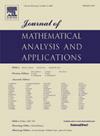On asymptotics of oscillatory solutions to nth-order delay differential equations
IF 1.2
3区 数学
Q1 MATHEMATICS
Journal of Mathematical Analysis and Applications
Pub Date : 2025-03-24
DOI:10.1016/j.jmaa.2025.129507
引用次数: 0
Abstract
We study bounded and decaying to zero solutions of the delay differential equation Kondrat'ev and Kiguradze introduced and defined principles of asymptotic behavior for its solution in the sense of the trichotomy: oscillatory, non-oscillatory with absolute values monotonically decaying to zero or monotonically increasing to ∞. Expanding upon such studies, we estimate the oscillation amplitudes of solutions. Decay to zero is established through fast oscillation: once distances between zeros are small enough, the Grönwall inequality growth estimate implies the amplitudes decrease to zero as . Exact growth estimates and calculation of these distances between zeros are proposed through evaluation for the spectral radii of some compact operators associated with the Green's function for an n-point problem.
关于n阶时滞微分方程振荡解的渐近性
研究了时滞微分方程x(n)(t)+∑i=1mpi(t)x(t - τi(t))=0fort∈[0,∞],t≥0,对于ξ<;0,x(ξ)=φ(ξ)的有界解和衰零解。Kondrat'ev和Kiguradze在三分法意义上引入并定义了其解的渐近行为原理:振荡的,非振荡的,绝对值单调衰减到零或单调递增到∞。在这些研究的基础上,我们估计了解的振荡幅度。衰减到零是通过快速振荡建立的:一旦零点之间的距离足够小,Grönwall不等式增长估计意味着振幅在t→∞时减小到零。通过对n点问题Green函数相关的一些紧算子的谱半径的求值,提出了精确的增长估计和这些零间距离的计算。
本文章由计算机程序翻译,如有差异,请以英文原文为准。
求助全文
约1分钟内获得全文
求助全文
来源期刊
CiteScore
2.50
自引率
7.70%
发文量
790
审稿时长
6 months
期刊介绍:
The Journal of Mathematical Analysis and Applications presents papers that treat mathematical analysis and its numerous applications. The journal emphasizes articles devoted to the mathematical treatment of questions arising in physics, chemistry, biology, and engineering, particularly those that stress analytical aspects and novel problems and their solutions.
Papers are sought which employ one or more of the following areas of classical analysis:
• Analytic number theory
• Functional analysis and operator theory
• Real and harmonic analysis
• Complex analysis
• Numerical analysis
• Applied mathematics
• Partial differential equations
• Dynamical systems
• Control and Optimization
• Probability
• Mathematical biology
• Combinatorics
• Mathematical physics.

 求助内容:
求助内容: 应助结果提醒方式:
应助结果提醒方式:


